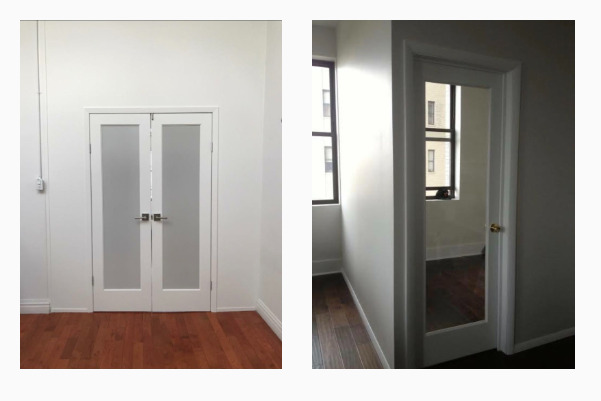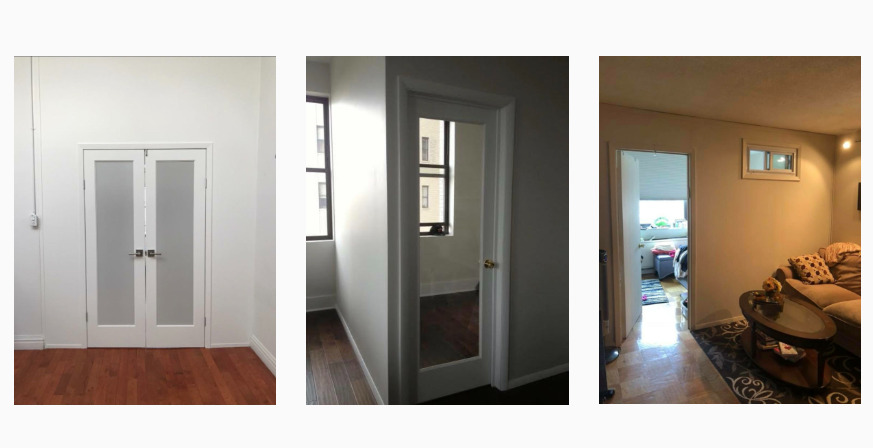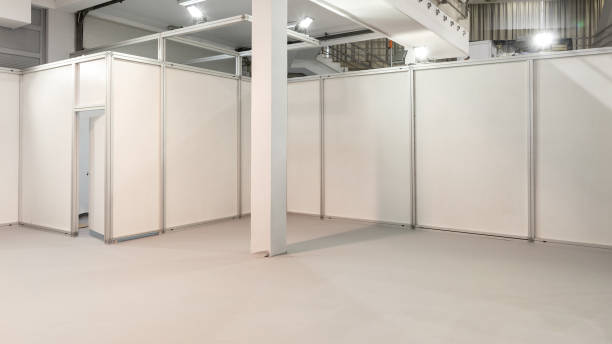


Temporary walls NYC is leading provider of pressurized wall in nyc, temporary walls in nyc, seamless walls in nyc. Temporary walls in NYC are a popular solution for homeowners in New York City who want to divide their living space without committing to a permanent wall. These walls are typically made of lightweight materials such as drywall or plywood and can be easily installed and removed as needed. They offer a cost-effective and versatile way to create separate rooms or areas within a home that can be customized to suit the homeowner’s needs.
Here is all you need to know about temporary walls in NYC.

Temporary walls are a practical solution for a variety of situations. Some benefits of using temporary walls include the following:
Temporary walls are designed to be easily installed and removed, which means they can be used to create various layout configurations. This can be useful in a number of situations, such as when you need to divide a large space into smaller rooms for a specific event or when you want to change the layout of your home or office without making any permanent changes.
Temporary walls are often more affordable than permanent ones, making them a cost-effective option for people who need to divide space but don’t want to invest in a permanent structure.
Temporary walls can create a more peaceful environment by blocking out unwanted noise. This can be especially useful in shared living spaces, such as apartments or dorm rooms, where multiple people may be making noise at the same time.
Temporary walls can provide a sense of privacy in a shared space. For example, you could use a temporary wall to create a private bedroom or office within a larger open-plan living space.
Temporary walls are typically very easy to install and can often be done without the need for specialized tools or equipment. This means that you can quickly and easily divide a space into smaller areas without a lot of hassle.
Temporary walls can be used in a wide range of settings, from office spaces and studios to homes and event spaces. This versatility makes them a great option for anyone looking to create temporary or semi-permanent partitions in their space.
Because temporary walls are easily removed and relocated, they can help to reduce the amount of waste generated during construction or renovation projects. This can help to reduce the overall environmental impact of these projects.
There are several different types of temporary walls, including:
These walls use air pressure to create a barrier between two spaces. They are often used in office buildings and other commercial spaces to divide large rooms into smaller ones and can be easily removed and relocated as needed.
Fabric walls are made from a flexible material, such as canvas or nylon, and are typically used for temporary partitions in events and exhibitions. They are easy to install and remove and can be quickly reconfigured to create different layouts.
Freestanding walls are self-supporting structures that do not require any external support. They are typically made from lightweight materials, such as foam board or plywood, and can be easily moved and repositioned as needed.
Sliding walls are similar to freestanding walls, but they are mounted on tracks that allow them to slide open and closed. They are often used in offices and other commercial spaces to create flexible, adaptable workspaces.
Modular walls are made from individual panels that can be easily connected and disconnected to create different configurations. They are often used in schools, hospitals, and other settings where temporary walls are needed regularly.
When choosing a temporary wall, there are a few things to consider.
Before choosing a temporary wall, it’s important to consider why you need it and where it will be installed. For example, if you need a temporary wall to divide a room for a special event, you’ll want to choose a wall that is easy to install and remove. On the other hand, if you need a temporary wall for more permanent use, such as to divide a shared space in a home or office, you’ll want to choose a sturdier and more durable option.
There are several different types of temporary walls available, including freestanding partitions, accordion walls, and modular walls. Each type has its own advantages and disadvantages, so it’s important to choose the one that best fits your needs. Freestanding partitions are the most portable and easy to install, but may not be as sturdy as other options. Accordion walls are a good option for dividing larger spaces, but can be bulky and difficult to move. Modular walls are the most durable and customizable option, but also the most expensive.
Once you’ve chosen the right type of temporary wall, it’s important to follow the manufacturer’s installation guidelines carefully. This will ensure that the wall is properly installed and stable and will help prevent accidents or injuries. If you’re unsure how to install the wall properly, it’s a good idea to consult a professional contractor or manufacturer for guidance.
Installing a temporary wall typically requires a few basic tools, such as a drill, screws, and a level. Make sure you have all the necessary tools and materials before beginning the installation process. It’s also a good idea to have a helper on hand to assist with the installation, especially if the wall is large or heavy.
Temporary walls are designed to be portable and easy to move, but they should still be sturdy and stable. Before installing the wall, consider its weight and how it will be supported. If the wall is too heavy, it may be difficult to move and could cause damage to the floor or ceiling. If the wall is not properly supported, it could tip over and cause injuries. Make sure to follow the manufacturer’s guidelines for weight and stability to ensure the wall is safe and secure.
A temporary wall is a great solution for creating extra space in a home or office without the need for a permanent structure. Temporary walls can be used to divide a room into smaller sections, create a private workspace, or add an extra layer of soundproofing. They are also a cost-effective option compared to building a permanent wall. However, it’s important to consider your space’s specific needs and requirements before choosing a temporary wall, as well as any potential limitations or drawbacks. Overall, temporary walls can be a convenient and flexible solution for creating extra space and functionality in various settings.
The best renovations aren’t always the most expensive ones. Temporary walls are a great way to add space when you’re not sure how permanent it will be. They’re also an inexpensive way to add more bedrooms or kitchen cabinets without needing major renovations. In this article, we’ll cover the types and why temporary walls NYC are ideal for use in just about any room of your house—and why they might be right for your next project!
Temporary walls NYC are large panels that connect together to create a room. They’re made from lightweight material, which makes them easy to move around and take down when you want to change the layout of your space.

Pressurized walls are a great choice for temporary walls that need to be removed and reinstalled. They are easy to install and remove, as well as durable and long-lasting. They can also be customized with graphics, logos, and more.
Pressurized walls are made with a liquid material that is injected into the hollow cores of the panels at high pressure. Once this material has been injected into the panel, it expands to create a strong wall structure. This creates a rigid panel that is extremely strong and sturdy.
Easy installation process – No special tools or equipment is needed to install these walls. All you need are some basic tools like screwdrivers and hammers.
These panels can be easily removed and reinstalled at any time without causing damage .
Bookshelf walls are one of the most popular types of temporary wall systems. These walls can be used as a divider to create separate rooms, or you can use them as a bookshelf by hanging books on the shelves.
If you need to divide an open space into smaller rooms, you should consider using bookcase walls. These walls are made up of large wooden bookshelves that are placed at an angle so they look like they’re built into the wall. The large shelving units make it easy to divide an open space into separate rooms.
The biggest advantage of using bookcase walls is that they don’t require any construction work and they can be removed easily if needed. The only downside is that they may not be suitable for every situation. If you have high ceilings or limited floor space, this type of temporary wall system may not work for you.
Partial walls are a great option in spaces where you need to divide a room but don’t have the budget or desire to create a permanent solution. Partial walls can be installed quickly, so they’re perfect for short-term projects.
Partial walls consist of panels that attach to the wall with special brackets and hinges. The panels come in different sizes and can be placed anywhere along the wall, creating any configuration you desire. For example, if you want to divide a room into two equal parts, you could use two panels placed side by side and set them up so that they open like doors. Full-length panels create long walls that divide rooms in half vertically or horizontally.
Partial walls are often made of lightweight materials like plastic or fabric so they can be easily moved around when needed. They come in many colors and styles to match any décor and also have built-in soundproofing so they’re perfect for music studios!
Flex walls are an excellent choice for events where you need to create designated areas quickly and easily. The walls are lightweight and easy to set up without tools or heavy lifting equipment. Each panel comes with corner connectors that allow you to connect multiple panels together to create whatever size room you need.
The great thing about flex walls is they’re completely customizable! You can choose from different styles of fabrics like canvas or vinyl according to your event’s needs. You can also choose from different colors, patterns, and textures that match your theme or decorating style perfectly!
Here are some reasons why you should use temporary walls:
Temporary walls are a great way to divide a room and create an entirely new space. You don’t need to buy or rent an entirely new room—temporary walls will do just fine!
Temporary walls can be used as a temporary solution until you are ready to make a permanent change. If you are renting, temporary walls allow you to test whether you like the new space before committing .
Temporary walls can be an excellent way to add personality to your space. They allow you to change the look of a room with ease so that you don’t have to worry about making permanent changes.
If you love bright colors but are afraid of committing those colors permanently, consider installing temporary walls. When it’s time for them to come down, simply remove them and go back to neutral palettes until the next time inspiration strikes!
Temporary walls are an inexpensive alternative to permanent walls. Temporarily dividers can be used throughout the space, and they’re easy to install. You’ll save money on installation costs by hiring less labor compared to other types of room dividers. You can also reuse them if you need them again in another space.
Temporary divider walls are a great way to test out different options before committing yourself to a permanent solution . If your temporary wall is not useful after some time, then it’s just as easy to remove it as it was for you to put up!
You can remove the temporary wall and relocate it somewhere else. For example, if you are creating a temporary office for one of your employees, you can use the walls to create a private space where they can work . If they need to move their workspace, you can then take down the walls and put them back up at another location with ease. This is also useful if someone needs to move into a new apartment. By using temporary walls, they will be able to designate some rooms as bedrooms, office space, dining areas, and more.
Temporary walls can be a great solution for creating new spaces. They’re easy to install and take down, making them perfect for renters who don’t have the option of permanently altering their walls. Plus, they’re affordable compared with other options like drywall or plasterboard! If you’re looking for an inexpensive way to add some personality to your space, temporary walls could be exactly what you need. Get Quote